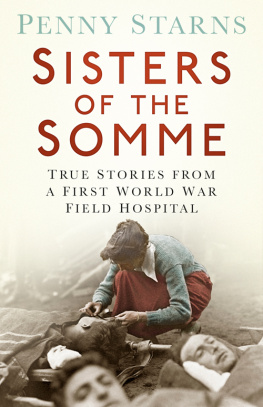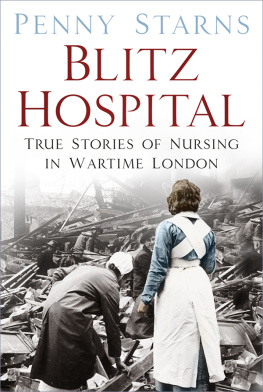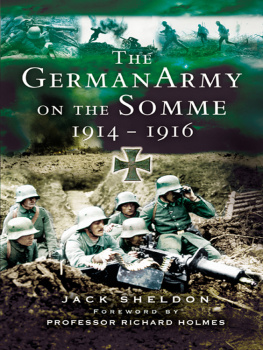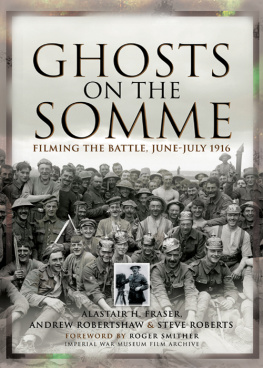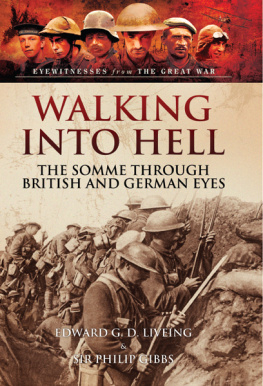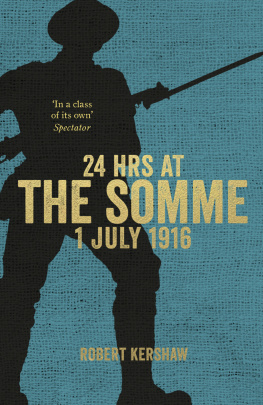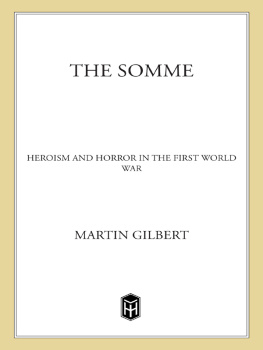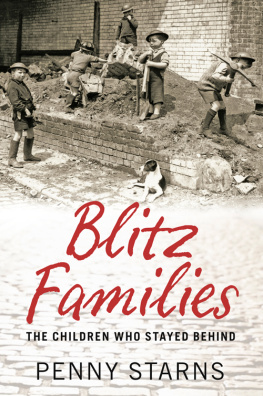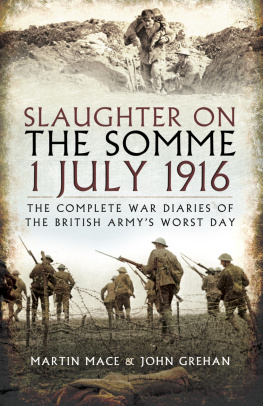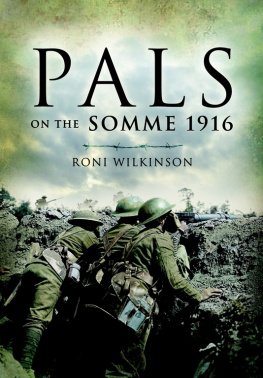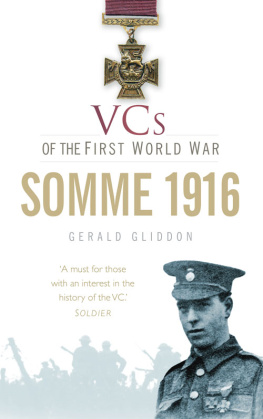
This book is dedicated to all the brave men and women who served at the Order of St John Ambulance Brigade Hospital between 4 September 1915 and 3 March 1919.
The process of writing this book has been greatly assisted by the staff of the Order of St John Museum, St Johns Gate, Clerkenwell, London. In particular, Tom Foakes, Abigail Turner, Hannah Agass, Charlotte Dickerson and Norman Gooding. Collectively they ensured that I had access to unique and fascinating primary source material contained within the Order of St John archive. They gave me their time and valuable insights into the humanitarian history of the Order, for which I am very grateful.
I extend special thanks to Mrs Eva Witton, great niece of VAD Veronica Nisbet, for giving me intimate details of Veronicas character and lifestyle.
I am indebted to my editor Sophie Bradshaw for her knowledge and guidance. I also thank my father for his constant support and encouragement.
In addition, I am grateful to those who have supported the research process by listening patiently to my ideas. These include Matthew Winstone, Michael and Rocha Brown, Joanna Denman, Catherine Nile, Pauline Hancock and Margaret Taplin.
C ONTENTS
This book adopts a new approach to First World War history by providing an intimate account of life in one base field hospital. It is based on the archive material belonging to the Museum of the Order of St John and other historical documents associated with the planning and work of the Order of St John Ambulance Brigade Hospital between 1914 and 1918. It documents both the routine and drama of field hospital life in France during the First World War, and follows the lives and interrelationships of hospital staff and patients. By focussing on one field hospital, this book sheds light not only on medical procedures, technologies and medicines but also on the levels of intimacy that were shared on a daily basis between people of varying backgrounds. Archive materials, in the form of diaries, letters, first-aid manuals, supply order books, military standing orders and official logbooks, detail everything from the weather, numbers of casualties, their treatment and medical outcomes, changes in hospital routine, boundary limits for medical personnel and patients, shortages of gauze dressings, the soaring price of coke used to fuel the stoves, burst pipes, blocked drains and some ongoing difficulties with electrical equipment. In amongst the mundane, however, records reveal the extraordinary nature of the Order of St John staff; the calm efficiency with which casualties were admitted, screened, treated and bedded down; and the immense bravery of personnel who often went above and beyond the call of duty in order to deliver urgently needed medical care to the severely injured.
In terms of archive material, special mention needs to be made of an article written by Lieutenant Colonel Ronnie Cole-Mackintosh entitled The St John Ambulance Brigade Hospital in taples. The lieutenant colonel fully intended to write and publish a book about the hospital but unfortunately passed away before he had chance to fulfil this ambition. The article he wrote for the Order of St John Historical Society is fascinating and detailed in its content, and it forms an important legacy.
In addition to the wealth of primary source material held at the Order of St John Museum, further documents held at the National Archive have also been consulted. These include War Office files, General Nursing Council files, treasury files, and Her Majestys Stationery Office (HMSO) advisory leaflets. A wide variety of documents held at the Royal College of Nursing Archives and the Imperial War Museum also contribute to the overall text of this book. Secondary material has been supplied by H. Cushing, From a Surgeons Journal (1936), M. Baly, Florence Nightingale and the Nursing legacy (1986) and the authors published PhD thesis March of the Matrons (2000).
The Order of St John of Jerusalem
In 1099 a group of monks in Jerusalem, under the direction of Brother Gerard, founded a hospital to care for sick pilgrims who were on their way to visit the Holy Land. Known as the hospitallers, those who cared for the sick did so in a way that was influenced directly by their Christian beliefs. All pilgrims, regardless of their race or creed, were cared for equally. Hospitallers were instructed to treat every patient as though they were caring for Christ himself. Therefore drinks were given in silver goblets and food was served to patients on a silver platter. From these humble beginnings of service and devout piousness, the Order of St John of Jerusalem was established, and it received official Church recognition in 1113. Once Jerusalem had been conquered during the Crusades, the hospitallers became the Knights of the Order of St John, and from this point on the Order adopted a militaryreligious role. The Order later branched out and initiated a number of worldwide humanitarian movements. The St John Ambulance Association in Great Britain was established in 1877, followed by the St John Ambulance Brigade in 1887. There was greater female involvement in the British Brigade during the early part of the twentieth century, and by 1915 women had taken on a variety of mens jobs within the St John Voluntary Aid Detachments. Establishing the Brigade Hospital in taples was the Orders most important initiative during the First World War. The Order of St John continues to fund a number of humanitarian projects throughout the world, and its influence remains undiminished.
The Field Hospital
In October 1914 the humanitarian organisation of the Order of St John of Jerusalem approached senior ministers at the British Government War Office and offered to provide a 520-bedded base hospital for the purposes of caring for wounded Allied personnel serving on the front line. This offer was duly accepted by the War Office, and 91,000 was raised by the British public by the end of 1914, in order to fund the building of the hospital.
Constructed in a prefabricated hut style, buildings were shipped across to Northern France and built according to the architects plan. In this way eighteen wards were established. These were divided into two straight lines, which were connected by a series of covered walkways, either side of an administration block. There were sixteen wards of thirty beds and two wards of twenty beds, eleven surgical and six medical. One of the smaller wards was reserved for the treatment of officers. Plaques above individual patient beds displayed the badge of the Order of St John in black and white, and all blankets were a silver grey with the same black-and-white Order badge placed at the centre. The hospital also boasted a modern laboratory and electro-cardiograph department, along with two operating theatres and an X-ray department.
The Order of St John of Jerusalem Ambulance Brigade Hospital was based at taples on the north coast of France and quickly became known simply as the Brigade Hospital. Staff consisted of a commanding officer, seventeen medical officers and surgeons, a dental surgeon, a quartermaster and secretary, a matron, an assistant matron, fifty-three trained nurses, twenty-four Voluntary Aid Detachment nurses (VADs) and 141 orderlies, all from the St John Ambulance Brigade and organised as a provisional company. The hospital was unique in many respects. The establishment was underpinned by a strong Christian ethos and almost entirely funded by voluntary contributions. The staff were trained and appointed by the St John Ambulance Brigade, and there was an efficient and crucial staff exchange scheme in operation between the hospital and the 130th St John field ambulance front-line unit. It was also the only hospital within the British Expeditionary Force to have the use of an electrocardiograph machine. This was the first time the machine had been used on active service. Throughout the war the hospital admitted primarily stretcher cases and sitters; the walking wounded were usually cared for elsewhere. There was an added strain on medical staff therefore, in that the hospital always admitted the most severely injured.
Next page
